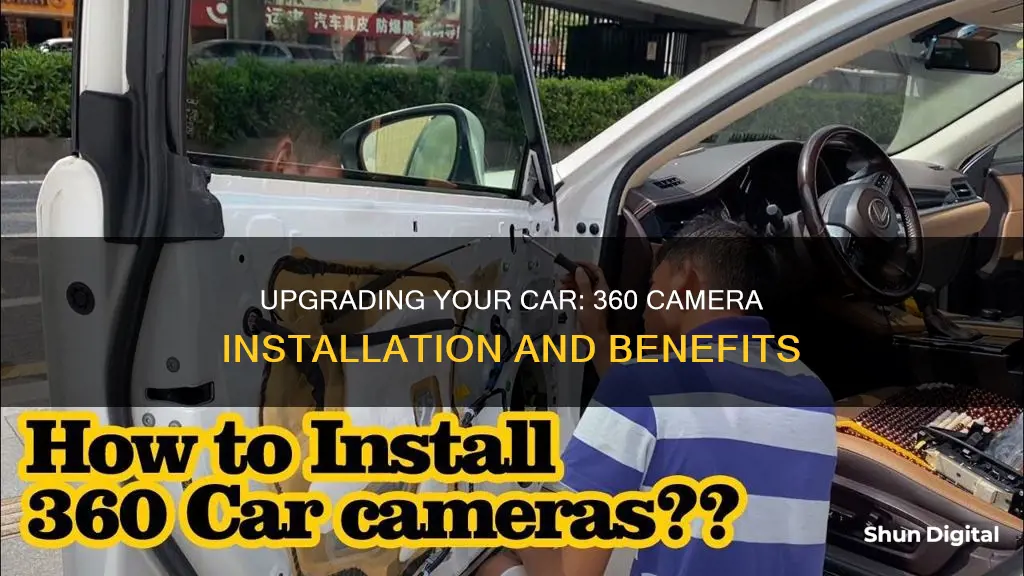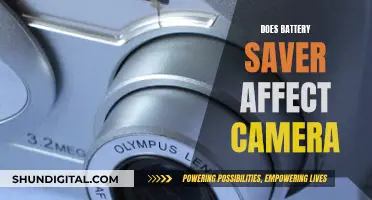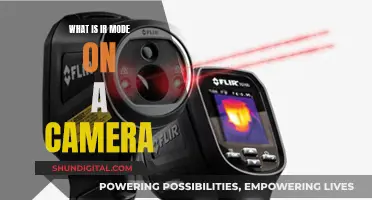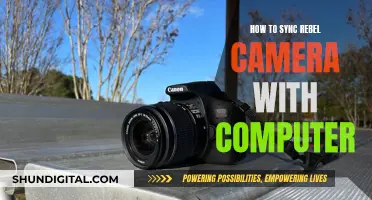
Upgrading your car with a 360-degree camera system can be a great way to improve your driving experience and safety. This technology provides a bird's-eye view of your vehicle and its surroundings, making parking and manoeuvring in tight spaces much easier. The system typically uses four or more cameras positioned around the vehicle to capture a panoramic view, which is then stitched together to create a seamless 360-degree image displayed on your vehicle's screen. While some newer car models offer built-in 360-degree camera systems, aftermarket options are also available for those who want to retrofit their vehicles. These aftermarket kits can be more challenging to install and may require professional help, but they offer a cost-effective way to enhance your driving experience.
What You'll Learn

The benefits of a 360-degree camera system
Upgrading to a 360-degree camera system for your car can bring a host of benefits that enhance your driving experience and safety. Here are some key advantages:
Enhanced Safety and Accident Avoidance
A 360-degree camera system significantly improves safety by eliminating blind spots and providing drivers with a comprehensive view of their surroundings. This increased visibility allows drivers to spot potential hazards, such as reckless drivers, pedestrians, or obstacles, and take necessary precautions to avoid accidents. The system offers a bird's-eye view, making it easier to navigate tight spaces and crowded parking lots without causing any damage to your vehicle or others.
Improved Parking Experience
The camera system is an invaluable aid when parking, as it shows the vehicle from a top-down perspective and helps you see exactly how close you are to other objects. Some systems even include parking assist features with audio and visual cues, making parking a breeze and reducing the risk of accidents in parking lots.
Better Visibility and Reduced Blind Spots
360-degree camera systems offer an unobstructed, panoramic view, enhancing your peripheral vision. This is especially beneficial when changing lanes or merging, as you can easily detect vehicles approaching from the sides or rear. The system also helps navigate narrow streets and crowded areas by revealing hidden obstacles, ensuring safer and more confident driving.
Protection Against Theft and Vandalism
The presence of visible cameras on your vehicle acts as a deterrent to potential thieves and vandals. They are less likely to target a vehicle with cameras, knowing their actions will be recorded. In the unfortunate event of theft or vandalism, the camera footage can provide valuable evidence to identify and prosecute the culprits, offering an added layer of security and peace of mind.
Improved Driving Habits and Reduced Insurance Costs
The camera system encourages safer driving habits by providing a visual record of your behaviour on the road. You can review the footage to identify any bad habits, such as speeding or failing to signal, and make necessary adjustments. Additionally, insurance companies often offer discounts to drivers with 360-degree camera systems, as they are considered a safety feature that helps avoid collisions and reduce the severity of accidents, ultimately saving you money on insurance premiums.
Can Someone Spy on You Through Your Computer Camera?
You may want to see also

How to choose the right 360-degree camera for your car
Upgrading your car with a 360-degree camera can be a smart move, offering improved visibility and enhanced safety. When choosing a 360-degree camera system for your car, there are several factors to consider to ensure you get the right one.
Firstly, you need to ensure it is compatible with your car. Most 360-degree camera systems require at least four cameras, with one at the front, two on the sides, and one at the rear. This means you will need to install the cameras on the car body, so check that they can be securely fitted to your vehicle. Some cars may also require additional hardware, such as a control box, to connect the cameras to your infotainment screen.
The quality of the cameras is also important. Look for cameras with wide-angle lenses, typically offering a view of up to 180 degrees, to ensure you get a good field of vision. The resolution of the cameras is also key; you want a crisp, clear image, so the higher the resolution, the better.
Additionally, consider the software that comes with the camera system. The software is responsible for stitching together the images from each camera to create a single, seamless, 360-degree image. The best software will provide a smooth, coherent image, allowing you to easily identify any obstacles around your vehicle.
Finally, think about your budget. 360-degree camera systems can vary significantly in price, from a few hundred to a few thousand dollars. Keep in mind that you may also need to pay for professional installation, which can add to the overall cost.
By considering these factors, you can choose the right 360-degree camera system for your car, improving your driving experience and safety.
Mounting Cameras on Cars: Professional Grip Techniques
You may want to see also

The cost of upgrading to a 360-degree camera system
Upgrading your car with a 360-degree camera system can be a costly affair, with the price depending on various factors. Firstly, the type of camera system you choose will impact the cost. Basic aftermarket kits can start from as little as $100, while more advanced systems with features like high-definition imaging and wide-angle views can cost upwards of $900. The camera resolution is an important consideration, as higher resolutions provide clearer images but usually come at a higher price.
Secondly, the complexity of the installation will affect the overall cost. Some cars may be prewired and more adaptable to aftermarket installations, resulting in lower installation prices. On the other hand, luxury vehicles or cars with complex electrical systems might require more intricate installation work, pushing the cost higher. Additionally, if your car requires special brackets or wiring kits, this can further increase the installation charges.
Thirdly, the make and model of your car will play a role in determining the cost of adding a 360-degree camera system. Larger vehicles, such as SUVs or trucks, may necessitate more sophisticated systems, leading to higher expenses. The exterior design of your car also matters, as it influences the optimal placement of the cameras to ensure unobstructed visibility.
Lastly, the cost of a 360-degree camera system can vary depending on whether you choose an aftermarket kit or an original equipment manufacturer (OEM) solution. Aftermarket kits offer more brand and feature options and are generally more affordable, with basic kits starting at around $100-$200. However, the quality can vary, and professional installation may be required, adding to the overall cost. In contrast, OEM solutions are fully integrated and quality-assured by the automaker but tend to be more expensive and limited to newer or high-tier models.
In summary, the cost of upgrading to a 360-degree camera system for your car can range from a few hundred to a few thousand dollars, depending on the factors mentioned above. It is important to carefully consider your budget, vehicle specifications, and intended use before making this enhancement to your driving experience and safety.
Are Police Cars Equipped With Cameras?
You may want to see also

How to install a 360-degree camera system in your car
Upgrading your car with a 360-degree camera system can be a great way to improve visibility and enhance your driving experience. Here's a step-by-step guide on how to install a 360-degree camera system in your car:
Step 1: Understand the Components
A 360-degree camera system typically consists of multiple cameras, strategically placed around your vehicle. The standard setup includes four cameras: one at the front, one at the rear, and one on each side, usually mounted on the side mirrors. These cameras work together to provide a comprehensive view of your surroundings.
Step 2: Purchase a Compatible System
When choosing a 360-degree camera system, ensure it is compatible with your car's infotainment screen or head unit. You can opt for an aftermarket kit, which typically includes the cameras, cables, and a control box. Some kits may also come with a display screen or remote control. Prices for these kits can vary, ranging from $200 to $900 or more.
Step 3: Prepare Your Vehicle
Before installing the cameras, thoroughly clean the areas where they will be mounted. This includes the front grille, side mirrors, and rear license plate area. It is important to ensure that the mounting surfaces are free of dirt, grease, or any debris that may interfere with the adhesion of the cameras.
Step 4: Mount the Cameras
Carefully position and mount the cameras on your vehicle. The front camera is typically installed in the middle of the front grille, while the side cameras are mounted on the side-view mirrors, facing downward. The rear camera is usually placed just above the license plate. It is important to ensure that the cameras are securely attached and properly aligned.
Step 5: Connect the Wiring
Connect the cameras to the control unit or infotainment system using the provided cables. Some modern systems may offer wireless connectivity, but most will require direct wiring. Route the cables discreetly along the vehicle's body, ensuring they are securely fastened and protected from potential damage.
Step 6: Calibrate the System
Once the cameras are installed and connected, you will need to calibrate the system. This process ensures that the images from each camera are properly aligned and stitched together to create a seamless 360-degree view. Calibration may involve using provided tapes or mats to adjust the camera angles and fine-tune their positioning.
Step 7: Test and Adjust
After calibration, test the 360-degree camera system to ensure it is functioning properly. Check the infotainment screen to see if all cameras are providing a clear and uninterrupted feed. Make any necessary adjustments to the camera angles or settings to optimize the system's performance.
Step 8: Professional Installation (Optional)
If you are uncomfortable with the installation process, consider having a professional install the 360-degree camera system. While it will incur additional costs, a professional installer can ensure the system is properly integrated and calibrated. They will have the experience and tools to complete the job efficiently and effectively.
By following these steps, you can successfully install a 360-degree camera system in your car, improving your visibility and making parking and manoeuvring in tight spaces much easier and safer.
Charging a Fuji X-30: A Quick Guide to Powering Up
You may want to see also

Tips for using your new 360-degree camera system
A 360-degree camera system is a great way to enhance your driving experience and safety. Here are some tips to help you get the most out of your new 360-degree camera system:
- Understand the components: The 360-degree camera system consists of multiple cameras with wide-angle lenses, proximity sensors, image processing software, and a display screen. Knowing how these components work together will help you make the most of your system.
- Utilize the split-screen view: The split-screen view allows you to see both the rearview and the surround-view images, which is especially useful when parallel parking or manoeuvring in tight spaces.
- Take advantage of proximity alerts: The 360-degree camera system can alert you to nearby objects, helping you avoid collisions.
- Use it for off-road driving: The system can also be helpful when driving off-road, providing a clear view of obstacles and the surrounding area.
- Consider the placement of cameras: Ensure that the cameras have a clear view of the vehicle's perimeter and that they do not disrupt the aesthetics or functionality of your car.
- Calibrate the cameras properly: Intrinsic and extrinsic camera calibration is crucial for optimal performance. Improper calibration can lead to issues such as non-aligned output images and faulty colours.
- Look for additional features: When choosing a 360-degree camera system, consider models that offer night vision, GPS functionality, and WiFi connectivity for enhanced performance and convenience.
- Ensure sufficient storage capacity: Opt for a system with ample storage space, especially if you drive for extended periods. This will ensure that you can capture and store all the necessary footage.
- Consider ease of use: Choose a system with a user-friendly interface and intuitive controls for easy operation while driving.
- Regularly review footage: Take advantage of the detailed footage captured by your 360-degree camera system to review your driving behaviour and identify areas for improvement.
- Utilize the theft deterrence feature: In addition to enhancing your driving experience, the 360-degree camera system can also provide peace of mind by deterring theft and helping resolve disputes after collisions.
Florida School Bus Camera Tickets: What's the Law?
You may want to see also
Frequently asked questions
A 360-degree car camera system uses multiple cameras positioned around the vehicle to provide a composite overhead view, eliminating blind spots and making parking easier and safer.
The cost of a 360-degree car camera system varies depending on the make and model of your vehicle, as well as whether you choose an aftermarket or factory-installed option. Aftermarket kits can range from $200 to $900, while factory-installed options are typically included in higher trim levels or bundled with other features, increasing the price by several thousand dollars.
In addition to enhancing safety, a 360-degree car camera improves visibility and makes parking and manoeuvring in tight spaces much easier. The bird's-eye view provided by the camera system gives you a complete surround view of your vehicle, helping to prevent accidents and protect pedestrians.







